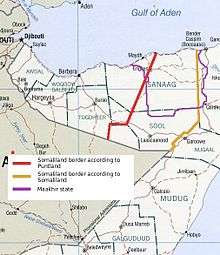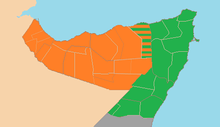Puntland–Somaliland dispute

The Puntland–Somaliland dispute is a territorial dispute over the northern Somali provinces of Sool, Sanaag and Cayn (SSC) between the autonomous Puntland and Somaliland regions of Somalia.[1][2][3][4]
The dispute

Background
The dispute between Somaliland and Puntland stems from 1998, when Puntland formed and declared the region as part of its territory.[5] Prior to that, it had been claimed by Somaliland since the 1991 events of the Somali Civil War.
Puntland claims Sool, Sanaag and Cayn (SSC) based on kinship ties with the regions' dominant Darod clans. Somaliland claims the territory as part of the original bounds of the former British Somaliland protectorate, which the self declared country regards itself as the successor to.[6] Fighting between the two forces led to casualties and captured prisoners, who were later exchanged.
Sanaag
Sanaag is a disputed region, claimed as sovereign territory by Puntland and Somaliland, two autonomous macro regions of Somalia.
The dispute with the Transitional Federal Government (TFG) stems from the passage of the new Charter in November 2004. However, this was not a pragmatic issue until the military successes of the government in the 2006–2007 war in Somalia. Assertions of sovereignty in January 2007 by the TFG leadership sparked riots in Somaliland.[7][8]
On July 1, 2007, the state of Maakhir was declared in Sanaag. The polity's leaders claimed independence from both Puntland and Somaliland,[9] but Maakhir was later officially incorporated into Puntland in January 2009.[10]
On 20 July 2013, an agreement between local elders in the south of Sanaag Region [northern Somalia] and the Somaliland administration led to the defection of the fighters in an attempt to combine the previously warring forces. "We had discussions and we agreed to work together on security in the area," Somaliland information minister Abdullahi Ukuse, adding that "the defecting force is made up of 500 fighters, 13 technicals and six lorries. These fighters were previously adversaries of the [Somaliland] military. The two forces are now one army." Other sources estimated that somewhere between 500 to 800 soldiers defected and integrated with the Somaliland army. A defecting Khaatumo state commander said he was happy that he joined the Somaliland troops, promising to help beef up security in the region.[11]
On 12 June 2014, heavily armed Somaliland regional administration forces entered Hingalol town. According to Puntland MP Abdihakim Abdullahi, they arrived in 13 battle wagons and were repeatedly told by local elders to leave the town or they would encounter resistance. Puntland elder Garad Abdullahi Ali Eid similarly indicated that before the Somaliland forces' began their march toward the area, Puntland clan elders had met with them and requested that they not enter the town ahead of a scheduled June 15 clan convention.[12]
Sool
Sool is a disputed region, claimed as sovereign territory by both the Somaliland and Puntland administrations. During 2006, the Islamic Courts Union (ICU) also incorporated sharia courts in Sool region into their loose alliance, though their military forces never occupied the region.
Under the government of Siad Barre, Sool was not a separate region, but part of the larger Nugaal province, with the capital city of Garowe. It was separated from Nugaal in the 1980s.[13]
Cayn
The area, centered on the town of Buuhoodle, is also disputed by Somaliland and Puntland. According to Somaliland, the so-called Cayn (or Ayn) area claimed by Puntland remains part of the Togdheer region. Somaliland disputes the territorial claims of Puntland, which wrote the claim on the portion of Togdheere into their 1998 charter.[5]
Troops from Somaliland and Ethiopia entered this region on 15 May 2010, in order to out down resistance to the upcoming Somaliland elections. Troops searched several towns and villages, including Buuhoodle, for local clan militia supporting Puntland. These forces clashed with local militia, leaving at least 13 dead on 33 wounded.
Armed clashes
Capture of Las Anod
In October 2007, the conflict mushroomed into a regional conflict over control of the city of Las Anod, as Somaliland regular army forces mobilized from their base in the town of Adhicadeeye, west of the city, and entered the conflict. Puntland was slow to mobilize a counter-attack, as Puntland's weak economy and overstretched military obligations in Mogadishu prevented a rapid response. After getting the city under its control, Somaliland moved Sool's regional administration into Las Anod.[14] Between 10 and 20 people were reported to be dead.[15]
2010 clashes
In 2010 Ethiopian and Somaliland forces engage an autonomist militia in northern Somalia's Sool region in a bid to pacify the region ahead of the 201 Somaliland presidential election. Ethiopian troops entered had southern Somalia to fight Islamist militants on previous occasions, but it is believed to be the first time that they had done so in Somaliland, which is generally seen as more stable than Somalia.
See also
| Wikimedia Commons has media related to Somali Civil War. |
Notes
- ↑ http://www.reuters.com/article/somalia-conflict-idUSL2E8D9BN420120210
- ↑ http://www.lib.utexas.edu/maps/somalia.html
- ↑ http://www.bbc.com/news/world-africa-14115069
- ↑ "Map of Somalia: Federal Member State and Interim Regional Administrations -" (PDF). page 3.Chatham House.
- 1 2 "Remarks on the 1998 Charter of Puntland State of Somalia". Somalia Watch. 2000-08-12. Retrieved 2007-01-18.
- ↑ Muse, Abdirashid. "Khaatumo II Conference Results in Further Balkanization". Somalia Report. Retrieved 2 July 2012.
- ↑ "Anti Somalia government protest rages in Somaliland". SomaliNet. 2007-01-16. Retrieved 2007-01-16.
- ↑ "Pro-government rally take place in northwest Somalia". Shabelle Media Network. 2007-01-17. Archived from the original on September 30, 2007. Retrieved 2007-01-19.
- ↑ The Formation of The Maakhir State of Somalia
- ↑ Worldstatesmen – Maakhir
- ↑ "Hundreds of Somali regional troops defect to breakaway Somaliland." news board, 20 July 2013. Web. 27 June 2014.
- ↑ "Somaliland troops enter disputed Hingalol town in Sanag". Sabahi. 12 June 2014. Retrieved 27 June 2014.
- ↑ "Somalia (1988)". CIA. December 1988. Retrieved 2007-02-21.
- ↑ Hoehne, Markus Virgil 2007: Puntland and Somaliland clashing in northern Somalia: Who cuts the Gordian knot?, published online on 07 November 2007
- ↑ allAfrica.com: Somalia: Over 20 People Killed in Fresh Fighting Between Somaliland And Puntland States (Page 1 of 1)
References
- H. J. de Blij, Peter O. Muller, Antoinette WinklerPrins, Jan Nijman, The World Today: Concepts and Regions in Geography, (John Wiley & Sons: 2010)
- Puntland Constitution
Further reading
- Hoehne, Markus V. 2007: Puntland and Somaliland clashing in northern Somalia: Who cuts the Gordian knot?, published online on 7 November 2007. http://hornofafrica.ssrc.org/Hoehne/
- Hoehne, Markus V. 2009: Mimesis and mimicry in dynamics of state and identity formation in northern Somalia, Africa 79/2, pp. 252–281.